MICHIGAN'S VEGETATION
Michigan was, for the most part, forested prior to European settlement.
The map below shows major vegetation assemblages for North America, and illustrates
that Michigan's forests were primarily of the "mixed" type---that is, part
broadleaf trees and part conifers.
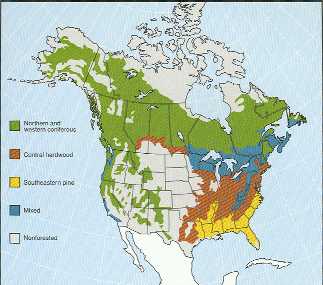
Click here for full size image (333 KB)
Source: Unknown
Actually, when examined on a finer scale, Michigan's forests can be divided into two major groupings: the deciduous forests (oaks, hickories, maples, beech) to the south, and mixed forests (pines, spruces, firs, beech, maples, oaks, aspen) to the north. The map below shows the general location of the boundary between these two forest provinces--called the floristic "tension zone".
Climate effects on forest patterns
Certain patterns in the present composition of forests in the Lower Peninsula
appear to be responses to climatic gradients that extend both south to north
and east to west across the state. Moving south to north through the Lower
Peninsula, one notices an increase in the number of evergreen (conifer) species.
These species (white spruce, balsam fir, jack pine) are boreal in distribution
but extend south into northern Michigan on upland sites where they are usually
only minor associates of other native hardwoods (though jack pine occurs
extensively on sandy uplands). Apparently sensitive to warm, dry summers
and neutral or basic soils, and unable to compete with more temperate-climate
associates, they are limited primarily to the northern Lower Peninsula--north
of a line from Bay City to Muskegon (the tension zone)--and to the Upper
Peninsula, where cooler summers and lower evaporation are typical, along
with the acidic, sandy soils on which these trees are most competitive. Warmer
summer weather with higher evaporation rates seem to restrict their occurrence
in southern Michigan.
Soil and topography effects on forest patterns
Probably no environmental factors account for more differences in forest
composition than do soil texture and topographic position. Both of these
factors strongly influence what amount of annual precipitation will actually
be available for plant growth on a given site and thus put limits on which
plants will be competitive there. Coarse, sandy soils are porous, have a
low water-holding capacity, are often acidic, and usually support trees such
as oaks and hickories--or in northern Michigan,
jack and red pine with a shrub layer of blueberries. Soils of intermediate
texture (loams) usually support a wide variety of species, but shade-tolerant
hardwoods such as beech and sugar maple
often dominate these sites. In the northern Lower Peninsula, hemlock and
yellow birch may prevail along with beech and maple, and in the western Upper
Peninsula, where there are no beeches, red oak and basswood are important
also. Heavy, clay-rich soils with poor internal drainage may support communities
of red or silver maple, ash, elm, and red oak.
The complex glacial history of the state left a jumbled
array of sediments that became soil, and since the
soil influenced the composition of both the primeval and present forests,
much of the patchwork of local forest patterns can be traced directly back
to the state’s glacial heritage. Topography influences forest composition
in that it is one of the factors that determines how far below-or above-ground
the water table will be. The woodlands that occupy low, boggy sites throughout
the state are among the most striking examples of this control. Bog vegetation generally exists where the water
table is at or slightly above the surface much of the year and where that
water is poor in minerals. Cold, poorly aerated soils discourage thorough
breakdown of organic matter, and therefore encourage the development of acidic
peat deposits. Such sites are heavily dominated by Canadian (boreal) elements throughout Michigan--spruce, fir,
larch, leatherleaf, blueberry--as these are the only plants that can be competitive
on acidic, cold sites.
The distribution of remnants of tall-grass prairie, found largely in southwestern
lower Michigan, is also partly related to topography. Vestiges of an earlier
prairie advanced into that part of the state from Illinois and Indiana during
a period of warmer, drier climate, and these prairies and oak openings persisted
on scattered patches of level or nearly level land of medium-or-better drainage
until European settlement. Presumable, the low relief of these sites exposed
them to a higher wind and fire risk. Once started by natural or human causes,
fires could sweep across the flat terrain more easily than they could on
the adjoining hillier landscape, resulting in damage to the invading woody
vegetation and preserving the isolated prairie stands long after their former
connection with the continuous prairie in Illinois and Indiana had been closed
off by reinvading forests.
For the map below, what forest types are represented by blue and
green? Yellow is tallgrass prairie, red is mid-grass prairie, and tan
is shortgrass prairie.
The image below is an interesting satellite composite of the percentage
of forest cover in the Great Lakes region. It shows nicely the large
amount of forested land in the UP, and the abrupt change from forest to grassland
in NW Minnesota.
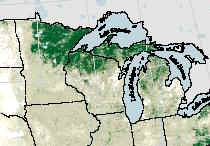
Source: Unknown
The map below is a choropleth representation of forest cover.
Source: Unknown
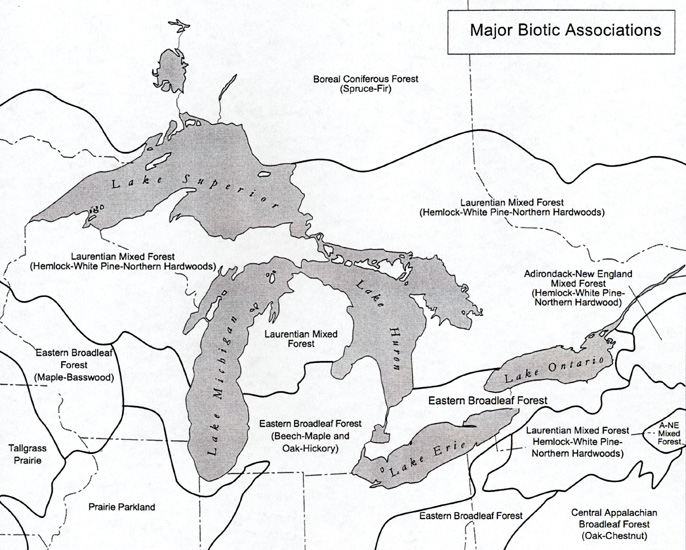
Source: Image Courtesy of Randy Schaetzl, Professor of Geography - Michigan State University
One way to evaluate the forest and vegetation resources of the state is to examine what they were like prior to European settlement. The series of maps below will give you an idea as to the patterns of vegetation in Michigan in the early 1800's. They start out more general, and become more detailed father down the page.
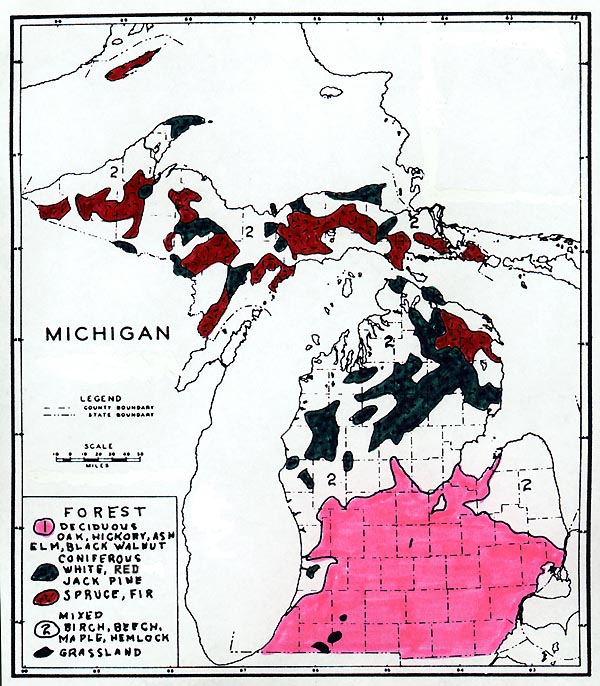
Source: Unknown
Michigan lies largely within the northern hardwood forest region, with areas
of the central hardwood region extending up into the southeastern part of
the state, and with pines, aspen and swamp conifers occupying large areas
in the northern part. Lines between these broad forest classifications are
frequently irregular, and within each are many different types, phases, and
temporary conditions, overlapping and changing with local variations of climate,
soil, and moisture.
Presettlement forest types have generally been described
as primarily deciduous (hardwood) with oak, maple and beech in the southern
lower peninsula, changing to mixed deciduous/coniferous species groups including
maple, birch, hemlock, and pine further north. In reality, forest cover conditions
were much more complex. The southern lower peninsula was dominated by large
expanses of oaks where soils were drier, portions of savanna in the southwest,
and maples, elm, and ash in wetter soils near the Saginaw Valley. Settlement
removed the majority of mature hardwood forests throughout the south. Woodlots,
seldom larger than 100 acres adjacent to farmland, continue to be fractured
into smaller parcels near suburban areas.
The Upper Peninsula is dominated by northern hardwood
forests which occupy the better upland soils and which also occur in poorer
quality on lighter soils. These stands include principally sugar maple, elm,
basswood, and yellow birch, with beech present in the east half of the peninsula,
and with hemlock and white pine often in mixture. The large areas of sandy
plains found in many parts of the peninsula mostly support pines. Spruce,
balsam, cedar, and tamarack (larch), the swamp conifers, generally occupy
the poorly drained sites, while extensive areas of aspen occur throughout,
principally on burned-over lands.
In the Lower Peninsula northern hardwoods occupy the
extreme northern part, extending in a broad band along the northwest side
and into the central and southwestern sections. Yellow birch, hemlock, and
white pine occur with less frequency or are entirely absent in these stands
below the center of the state. Pine occurs principally in the broad sand
plains and hills region in the north central and northeast parts. Aspen covers
extensive areas of old burns throughout the north half of the Lower Peninsula,
while the swamp conifers occupy the poorly drained and wet sites.
The central hardwoods in general occupy the southeast
part of the Lower Peninsula and are characterized by the oaks and hickories
on the dry hilly soils, and by such species as sycamore, cottonwood, and
silver maple on the heavier soils and bottom lands.
Human intervention, such as harvesting, fire and clearing
for development, has profoundly affected the composition of Michigan’s forest
base. While the area of forest coverage has generally rebounded since the
timber boom period of the last century, few regions of the State contain
the same mixture of tree species that existed prior to settlement.
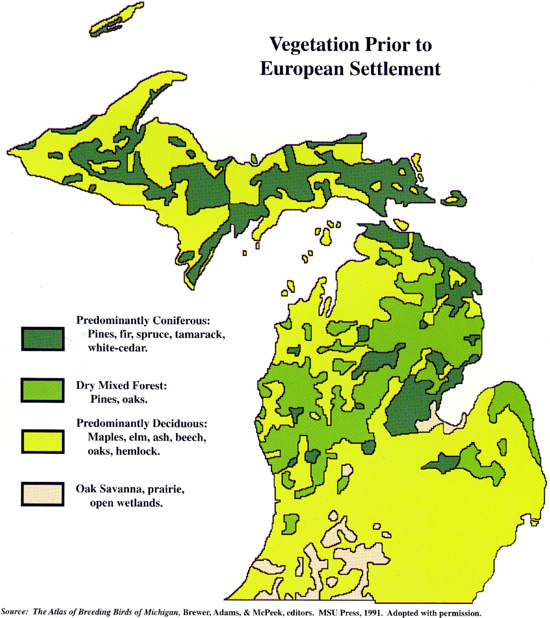
This "placemat" map was produced by the Michigan Geographic
Alliance and the Science/Mathematics/Technology Center, Central Michigan
University, with funding from the U.S. Dept. of Education. For further information
email Wayne.E.Kiefer@cmich.edu
Source: Atlas of Michigan, ed. Lawrence M. Sommers, 1977.
How do we know so much about presettlement vegetation patterns? Our
data come form the US Public Land Surveyors' records
and field notes. Recall that most of the United States west of the
original 13 Colonies was surveyed under the edicts of the Land Ordinance
of 1785 and Northwest Ordinance of 1787. These laws provided for the division
of unincorporated federal territory into six-by-six mile square townships
which were further subdivided into 36 sections each one square mile. In assaying
federal lands, contracted surveyors were also instructed to record things
like the condition of the land, its potential for agriculture, etc. Most
importantly for us, however, they also were required to note the species
and diameters of two or four trees at each section corner (i.e., 8-16 per
square mile), as well as major trees that fell on the section lines proper
(usually 5-15 per squate mile section). That’s a lot of trees! And that’s
a lot of paleo-vegetation information that we can use today to reconstruct
past forests! These General Land Office (GLO) archives--aside from their
valuable historical accounts and descriptions--have thus served as an important
data source for the reconstructing presettlement vegetation and ecology in
Michigan and elsewhere in the eastern United States.
Michigan's current vegetation has been dramatically changed by its
inhabitants, as the map below shows.
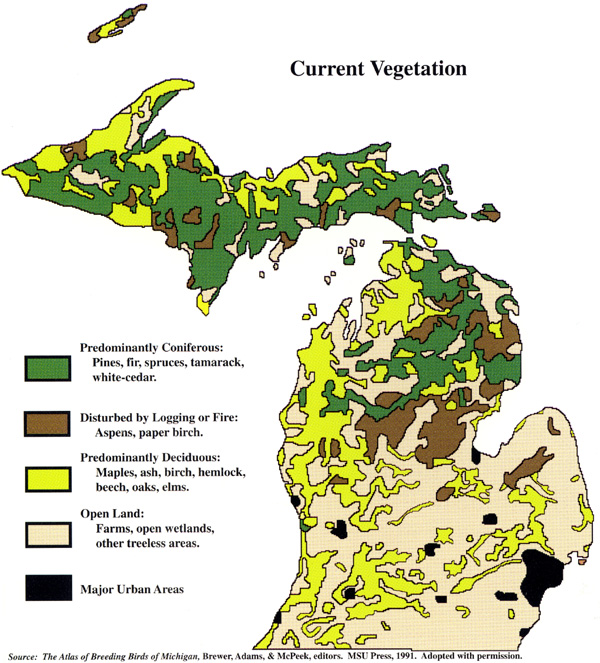
This "placemat" map was produced by the Michigan Geographic Alliance and the Science/Mathematics/Technology Center, Central Michigan University, with funding from the U.S. Dept. of Education. For further information email Wayne.E.Kiefer@cmich.edu
LIST OF TREE SPECIES FOUND IN MICHIGAN
1. Oak-Savanna Community
Bur oak Quercus macrocarpa
Black oak Quercus velutina
Northern pin oak Quercus ellipsoidalis
2. Oak-Hickory Community
White oak Quercus alba
Black oak Quercus velutina
Red oak Quercus rubra
Pignut hickory Carya glabra
Shagbark hickory Carya ovata
Black cherry Prunus serotina
Hop-hornbeam Ostrya virginiana
White ash Fraxinus americana
Witch-hazel Hamamelis virginiana
Downy serviceberry Amelanchier arborea
Flowering dogwood Cornus florida
Eastern redcedar Iuniperus virginiana
Chinkapin oak Quercus muehlenbergii
Dwarf chinkapin oak Quercus prinoides
American chestnut Castanea dentata
Dwarf hackberry Celtis tenuifolia
3. Beech-Sugar Maple Community
Beech Fagus grandifolia
Sugar maple Acer saccharum
Red oak Quercus rubra
Basswood Tilia americana
White ash Fraxinus americana
Black walnut Juglans nigra
Tuliptree Liriodendron tulipifera
Bitternut hickory Carya cordiformis
Shagbark hickory Carya ovata
Slippery elm Ulmus rubra
Rock elm Ulmus thomasii
Alternate-leaf dogwood Cornus alternifolia
Blue ash Fraxinus quadrangulata
Downy serviceberry Amelanchier arborea
4. Deciduous Swamp Community
Red maple Acer rubrum
Black ash Fraxinus nigra
Yellow birch Betula alleghaniensis
American elm Ulmus americana
Silver maple Acer saccharinum
Blue-beech Carpinus caroliniana
Alternate-leaf dogwood Cornus alternifolia
Nannyberry Viburnum lentago
Pin oak Quercus palustris
Swamp white oak Quercus bicolor
5. Pine Community
Jack pine Pinus banksiana
Red pine Pinus resinosa
Eastern white pine Pinus strobus
White oak Quercus alba
Northern pin oak Quercus ellipsoidalis
Black oak Quercus velutina
Pin cherry Prunus pensylvanica
Scarlet oak Quercus coccinea
Parts of the text above have been paraphrased from
C.M. Davis’ Readings in the Geography of Michigan
(1964).
Parts of the text on this page have been modified from L.M.
Sommers' book entitled, "Michigan: A Geography".
This material has been compiled for educational use only, and may not be reproduced without permission. One copy may be printed for personal use. Please contact Randall Schaetzl (soils@msu.edu) for more information or permissions.